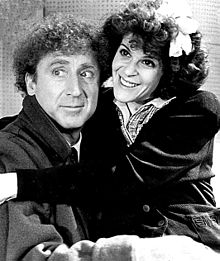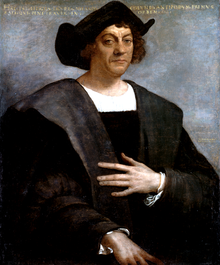On this day in 1506, explorer, colonizer, and navigator, Cristóbal Colón, Cristoforo Colombo, Christopher Columbus died in Valladolid, a historic city and municipality in north-central Spain at the age of 55. Born Cristoforo Colombo sometime between 25 August and 31 October 1451 in Genoa, Republic of Genoa, in present day Italy. The name Christopher Columbus is the Anglicisation of the Latin Christophorus Columbus. In Spanish, it is Cristóbal Colón. Columbus’s proposal to reach the East Indies by sailing westward, thereby opening new trade routes, appealed to the Catholic Monarchs of Spain, Ferdinand II of Aragon and Isabella I of Castile, amid emerging western imperialism and economic competition. During his first voyage in 1492 (in 1492 Columbus sailed the ocean blue), Columbus landed in the Bahamas archipelago, not Japan as he had intended. He made a total of four voyages, visiting the Greater and Lesser Antilles, as well as the Caribbean coast of Venezuela and Central America, claiming them for the Spanish Empire. Columbus was not the first European explorer to reach the Americas. His voyages were preceded by a Norse expedition led by Leif Ericson, some five centuries earlier. But it was Columbus’s voyages that led to lasting European contact with America and the resulting historical development of the Western world. Conventional wisdom has it that Columbus never admitted that he had reached a continent previously unknown to Europeans, and at his death, he was still convinced that his journeys had been along the east coast of Asia. Columbus called the inhabitants of the lands he visited indios (Spanish for “Indians”). See the comment below for additional perspective.
The Final Footprint – A voyager in life, perhaps it is fitting that he became a voyager in death. Columbus was first interred at Valladolid, then at the monastery of La Cartuja in Seville (southern Spain) by the will of his son Diego, who had been governor of Hispaniola. In 1542 the remains were transferred to Colonial Santo Domingo, in the present-day Dominican Republic. In 1795, when France took over the entire island of Hispaniola, Columbus’ remains were moved to Havana, Cuba. After Cuba became independent following the Spanish-American War in 1898, the remains were moved back to Spain, to the Cathedral of Seville, where they were placed on an elaborate catafalque. However, a lead box bearing an inscription identifying “Don Christopher Columbus” and containing bone fragments and a bullet was discovered at The Columbus Lighthouse in Santo Domingo in 1877. To lay to rest claims that the wrong relics had been moved to Havana and that Columbus’ remains had been left buried in the cathedral at Santo Domingo, DNA samples of the corpse resting in Seville were taken in June 2003 (History Today August 2003) as well as other DNA samples from the remains of his brother Diego and younger son Fernando Colón. Initial observations suggested that the bones did not appear to belong to somebody with the physique or age at death associated with Columbus. DNA extraction proved difficult; only short fragments of mitochondrial DNA could be isolated. The mtDNA fragments matched corresponding DNA from Columbus’s brother, giving support that both individuals had shared the same mother. Such evidence, together with anthropologic and historic analyses led the researchers to conclude that the remains found in Seville belonged to Columbus. The authorities in Santo Domingo have never allowed the remains there to be exhumed, so it is unknown if any of those remains could be from Columbus’ body as well. The location of the Dominican remains is in “The Columbus Lighthouse” (Faro a Colón), in Santo Domingo.
#RIP #OTD in 1896 pianist, composer (Piano Trio in G minor, Op. 17; Three Romances for Violin and Piano), piano teacher, (wife of Robert Schumann) Clara Schumann died from a stroke in Frankfurt, aged 76. Alter Friedhof, Bonn
| Gilda Radner | |
|---|---|
 with husband, Gene Wilder, in the film Haunted Honeymoon, 1986 |
|
On this day in 1989, comedian, writer, actress, and one of the seven original cast members of Saturday Night Live (SNL), Gilda Radner died at Cedars-Sinai Medical Center in Los Angeles of ovarian cancer at the age of 42 with her husband Gene Wilder at her side. Born Gilda Susan Radner on June 28, 1946 in Detroit, Michigan. In her routines on SNL, Radner specialized in parodies of television stereotypes, including Roseanne Roseannadanna and “Baba Wawa”. She also portrayed those characters in her highly successful one-woman show on Broadway in 1979.
Radner’s SNL work established her as an iconic figure in the history of American comedy. Her autobiography dealt frankly with her life, work, and personal struggles, including those with the illness.
Radner met Wilder on the set of the Sidney Poitier film Hanky Panky (released in 1982), when the two worked together making the film. She described their first meeting as “love at first sight”. She was unable to control her attraction to Wilder as her marriage to guitarist G. E. Smith deteriorated. Radner went on to make a second film with Wilder, The Woman in Red (released in 1984), and their relationship grew. The two were married on September 18, 1984, in Saint-Tropez. The pair made a third film together, Haunted Honeymoon (1986) and remained married until her death in 1989.

 The Final Footprint
The Final Footprint
News of her death broke as Steve Martin was rehearsing to act as the guest host for that night’s season finale of Saturday Night Live. Martin’s planned opening monologue was scrapped; in its place Martin, in tears, introduced a video clip of a 1978 sketch in which he and Radner had parodied Fred Astaire and Cyd Charisse in a well-known dance routine from The Band Wagon (1953). After the clip, Martin said it reminded him of “how great she was and of how young I looked. Gilda, we miss you.”
Radner is interred in Long Ridge Union Cemetery in Stamford, Fairfield County, Connecticut.
Wilder, carried out her personal wish that information about her illness would help other cancer victims, founding and inspiring organizations that emphasize early diagnosis, hereditary factors and support for cancer victims.
#RIP #OTD in 2012 singer, songwriter, Bee Gees (“How Deep is Your Love”, “More than a Woman”, “Stayin’ Alive”, “You should be Dancing”), Robin Gibb died from liver/kidney failure brought on by colorectal cancer in London, aged 62. Saint Mary The Virgin Church, Thame, England
#RIP #OTD in 2013 keyboardist, songwriter (the Doors; “Light My Fire”, “People Are Strange”, “Break On Through (To the Other Side)”) Ray Manzarek died from bile duct cancer at a hospital in Rosenheim, Germany, at the age of 74. Cremation
Have you planned yours yet?
Follow TFF on twitter @RIPTFF




This article spells out the conventional history on Columbus but it is very flawed with the facts. First, Columbus was never called Columbus but Colón and among the many misunderstandings propagated by historians is the idea the Colón never knew he had reached a “New World.”
This statement is not true. In at least three different letters Admiral Colón admitted he had reached NEW LANDS until then unknown:
“Y Vuestras Altezas ganaron estas tierras, tantas, que son otro mundo…” (And Your Highnesses have gained these lands, many, which are another world..)
“Puesto so el señorío del Rey e de la Reina, Nuestros Señores, otro mundo…” (Put under the lordhsip of the King and Queen, Our Lords, another world…)
“Cometí viaje de nuevo al cielo y mundo que fasta entonçes estaba oculto…” (I made a trip anew to the sky and world that until then had been hidden…)
May I suggest that you talk to historian Manuel Rosa, author of Columbus. The Untold Story if you want to understand where the Columbus history went arwy.